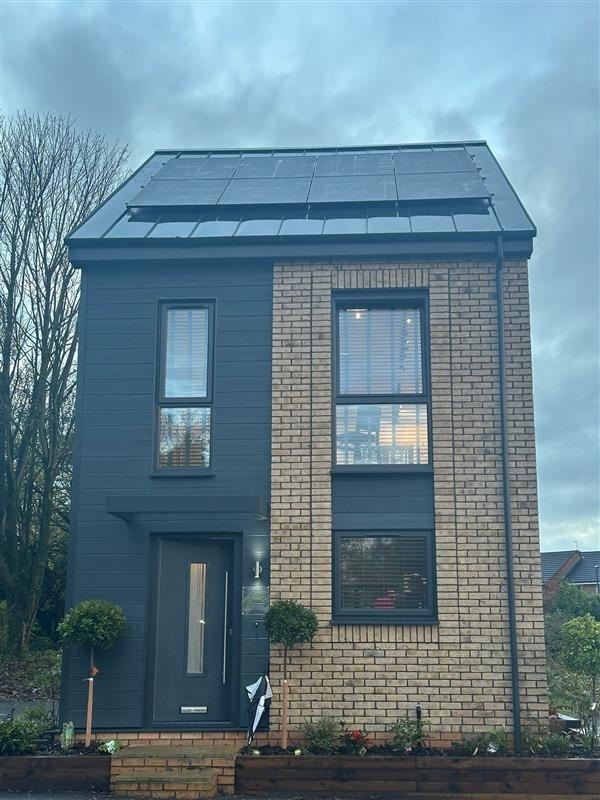
A new eco-friendly, social housing development in Scunthorpe has become one of the first major sites within the UK to benefit from Thermally Broken Lintels. Here, Catnic looks at how our new generation of composite steel lintels are helping to provide a high performance solution.
For housing developments taking a fabric first approach to energy efficiency, understanding how individual building components and materials perform is absolutely crucial in order to achieve the best possible results. Addressing energy loss has to be high on the agenda and historically, without careful planning and because of its ability to conduct heat - a steel lintel can create an ideal path for energy loss through a wall.
The good news for local authority specifiers is that with a new range of unique lintels – there is a solution. For example, the team responsible for the Bridgwater Road development in Scunthorpe needed building components and materials, which would help each property to meet the necessary thermal performance targets, minimise environmental impact and to reduce fuel costs for occupants. The choice of lintels was a key factor.
Bridgwater Road – Building it Better
Bridgewater Road is a scheme of 20 houses being developed on a previously neglected area of land situated off of Plymouth Road in Scunthorpe. It was in May 2016, that local housing provider Ongo Homes appointed building contractor T G Sowerby to redevelop the estate into contemporary, eco-friendly semi-detached homes and detached bungalows.
As part of its remit, T G Sowerby Limited selected a range of products from Catnic’s new Thermally Broken Lintel range, which deliver industry-leading Psi values. Each delivers the thermal performance of not one but two separate lintels, enabling a complete thermal break between the inner and outer leaf of a cavity wall.
Heat loss at any structural junction is measured as a Psi value, in W/mK. Combining this with the u-value of each plane element provides the overall heat loss through the fabric of the building. It is important to opt for lintels that will combine the required structural performance with the desired level of energy efficiency. Therefore a lintel with the lowest Psi-value and correct structural performance will provide the best possible results.
“Catnic’s Thermally Broken Lintels offer excellent Psi values and are the best performing on the market and helped us to significantly minimise heat loss through thermal bridges,” said Steve Sowerby, Director at T G Sowerby Limited.
Developing Bespoke Solutions
BSB Architecture designed the new Bridgewater Road development and John Mason, Scheme Architect commented on one of the project’s specific challenges: “We wanted to elevate the front of the houses, whilst making sure there were no gables spoiling the residents’ 180o vision of the street. To accomplish this the houses required bespoke bay windows. This meant we required durable and wider cavity lintels to support the unique design as well as achieve outstanding U-values.
A 150mm cavity is a significant ask for a lintel. Nevertheless, Catnic provided bespoke Thermally Broken Lintels. These achieved thermal efficiencies well in excess of current standards ensuring the Bridgewater properties are as sustainable and environmentally friendly as possible.” To manage this effectively, Catnic is dedicating a section of its factory specifically to manufacturing the bespoke, wider cavity 150mm Thermally Broken Lintels.
Lintels – A Vital Building Component
The new Thermally Broken Lintel range represents the most significant evolution in steel lintel engineering for a generation - allowing heat loss through window head details to be reduced by up to 96%.
The range has been designed to cover all building types from small domestic dwellings to large apartment buildings, including concrete floor loads. Lintels are available in standard, heavy duty and extra heavy duty specifications, according to the requirements of the project.
Today, ‘fabric first’ is firmly established as the most practical and effective means of addressing the energy efficiency and thermal performance of properties built and refurbished in the UK.
Clearly, a successful building can only ever be the sum of its many parts. Therefore when it comes to the specification of building components, local authority specifiers have a duty of care to ensure wherever possible, product selection is based on a component’s capability to contribute to that fundamental fabric first approach.
More
-
![]()
- SolarSeam
- Urban
Ultrapanel®and Catnic Urban Deliver a ‘House in a Day’.


